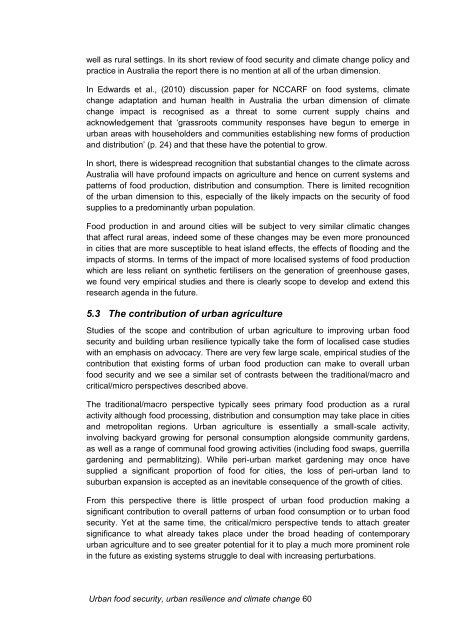Urban food security, urban resilience and climate change - weADAPT
Urban food security, urban resilience and climate change - weADAPT
Urban food security, urban resilience and climate change - weADAPT
Create successful ePaper yourself
Turn your PDF publications into a flip-book with our unique Google optimized e-Paper software.
well as rural settings. In its short review of <strong>food</strong> <strong>security</strong> <strong>and</strong> <strong>climate</strong> <strong>change</strong> policy <strong>and</strong>practice in Australia the report there is no mention at all of the <strong>urban</strong> dimension.In Edwards et al., (2010) discussion paper for NCCARF on <strong>food</strong> systems, <strong>climate</strong><strong>change</strong> adaptation <strong>and</strong> human health in Australia the <strong>urban</strong> dimension of <strong>climate</strong><strong>change</strong> impact is recognised as a threat to some current supply chains <strong>and</strong>acknowledgement that ‘grassroots community responses have begun to emerge in<strong>urban</strong> areas with householders <strong>and</strong> communities establishing new forms of production<strong>and</strong> distribution’ (p. 24) <strong>and</strong> that these have the potential to grow.In short, there is widespread recognition that substantial <strong>change</strong>s to the <strong>climate</strong> acrossAustralia will have profound impacts on agriculture <strong>and</strong> hence on current systems <strong>and</strong>patterns of <strong>food</strong> production, distribution <strong>and</strong> consumption. There is limited recognitionof the <strong>urban</strong> dimension to this, especially of the likely impacts on the <strong>security</strong> of <strong>food</strong>supplies to a predominantly <strong>urban</strong> population.Food production in <strong>and</strong> around cities will be subject to very similar climatic <strong>change</strong>sthat affect rural areas, indeed some of these <strong>change</strong>s may be even more pronouncedin cities that are more susceptible to heat isl<strong>and</strong> effects, the effects of flooding <strong>and</strong> theimpacts of storms. In terms of the impact of more localised systems of <strong>food</strong> productionwhich are less reliant on synthetic fertilisers on the generation of greenhouse gases,we found very empirical studies <strong>and</strong> there is clearly scope to develop <strong>and</strong> extend thisresearch agenda in the future.5.3 The contribution of <strong>urban</strong> agricultureStudies of the scope <strong>and</strong> contribution of <strong>urban</strong> agriculture to improving <strong>urban</strong> <strong>food</strong><strong>security</strong> <strong>and</strong> building <strong>urban</strong> <strong>resilience</strong> typically take the form of localised case studieswith an emphasis on advocacy. There are very few large scale, empirical studies of thecontribution that existing forms of <strong>urban</strong> <strong>food</strong> production can make to overall <strong>urban</strong><strong>food</strong> <strong>security</strong> <strong>and</strong> we see a similar set of contrasts between the traditional/macro <strong>and</strong>critical/micro perspectives described above.The traditional/macro perspective typically sees primary <strong>food</strong> production as a ruralactivity although <strong>food</strong> processing, distribution <strong>and</strong> consumption may take place in cities<strong>and</strong> metropolitan regions. <strong>Urban</strong> agriculture is essentially a small-scale activity,involving backyard growing for personal consumption alongside community gardens,as well as a range of communal <strong>food</strong> growing activities (including <strong>food</strong> swaps, guerrillagardening <strong>and</strong> permablitzing). While peri-<strong>urban</strong> market gardening may once havesupplied a significant proportion of <strong>food</strong> for cities, the loss of peri-<strong>urban</strong> l<strong>and</strong> tosub<strong>urban</strong> expansion is accepted as an inevitable consequence of the growth of cities.From this perspective there is little prospect of <strong>urban</strong> <strong>food</strong> production making asignificant contribution to overall patterns of <strong>urban</strong> <strong>food</strong> consumption or to <strong>urban</strong> <strong>food</strong><strong>security</strong>. Yet at the same time, the critical/micro perspective tends to attach greatersignificance to what already takes place under the broad heading of contemporary<strong>urban</strong> agriculture <strong>and</strong> to see greater potential for it to play a much more prominent rolein the future as existing systems struggle to deal with increasing perturbations.<strong>Urban</strong> <strong>food</strong> <strong>security</strong>, <strong>urban</strong> <strong>resilience</strong> <strong>and</strong> <strong>climate</strong> <strong>change</strong> 60
















